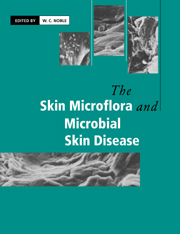Book contents
- Frontmatter
- Contents
- List of contributors
- Preface
- 1 The basis of the skin surface ecosystem
- 2 Nutrition of cutaneous resident microorganisms
- 3 Physical factors affecting the skin flora and skin disease
- 4 Coryneform bacteria
- 5 Coryneforms as pathogens
- 6 Staphylococci on the skin
- 7 Staphylococci as pathogens
- 8 Streptococci and the skin
- 9 Other cutaneous bacteria
- 10 Fungi and fungal infections of the skin
- 11 Bacterial and fungal skin disease in animals
- 12 Viral skin disease in man
- 13 Viral skin disease in animals
- 14 Microbial interactions on skin
- 15 Adherence of skin microorganisms and the development of skin flora from birth
- 16 Skin disinfection
- Index
16 - Skin disinfection
Published online by Cambridge University Press: 04 December 2009
- Frontmatter
- Contents
- List of contributors
- Preface
- 1 The basis of the skin surface ecosystem
- 2 Nutrition of cutaneous resident microorganisms
- 3 Physical factors affecting the skin flora and skin disease
- 4 Coryneform bacteria
- 5 Coryneforms as pathogens
- 6 Staphylococci on the skin
- 7 Staphylococci as pathogens
- 8 Streptococci and the skin
- 9 Other cutaneous bacteria
- 10 Fungi and fungal infections of the skin
- 11 Bacterial and fungal skin disease in animals
- 12 Viral skin disease in man
- 13 Viral skin disease in animals
- 14 Microbial interactions on skin
- 15 Adherence of skin microorganisms and the development of skin flora from birth
- 16 Skin disinfection
- Index
Summary
The purpose of skin disinfection is the removal of both transient and resident skin bacteria. The transient skin flora, which just happens to be deposited on the skin but does not multiply there, is removed rather easily, even with soap and water. The resident skin bacteria, which colonize and multiply on the skin, mostly persist after washing. Residents form microcolonies which are difficult to eradicate; these may contain between 100 and 1000 viable cells but can be reduced to smaller numbers with disinfectant (antiseptic). Resident skin bacteria are normally harmless to a surgical patient unless a prosthesis or catheter is inserted but may, on rare occasions, include pathogens such as methicillin-resistant Staphylococcus aureus (MRSA). Some transient bacteria on the skin, such as Clostridium perfringens, present as a result of faecal contamination from the buttocks, may resemble the resident flora in their persistence after washing with soap and water. During washing, but not disinfection, bacteria rubbed on to the skin are more persistent than those applied without rubbing.
The removal or killing of transient bacteria on the hands is often described as hygienic hand disinfection and the killing of resident bacteria as surgical hand disinfection. The disinfection of operating sites is also intended to kill the resident flora. The characteristics of six antimicrobial ingredients designed for topical application to the skin have been reported by Larson (Table 16.1).
- Type
- Chapter
- Information
- The Skin Microflora and Microbial Skin Disease , pp. 373 - 386Publisher: Cambridge University PressPrint publication year: 1993
- 1
- Cited by



